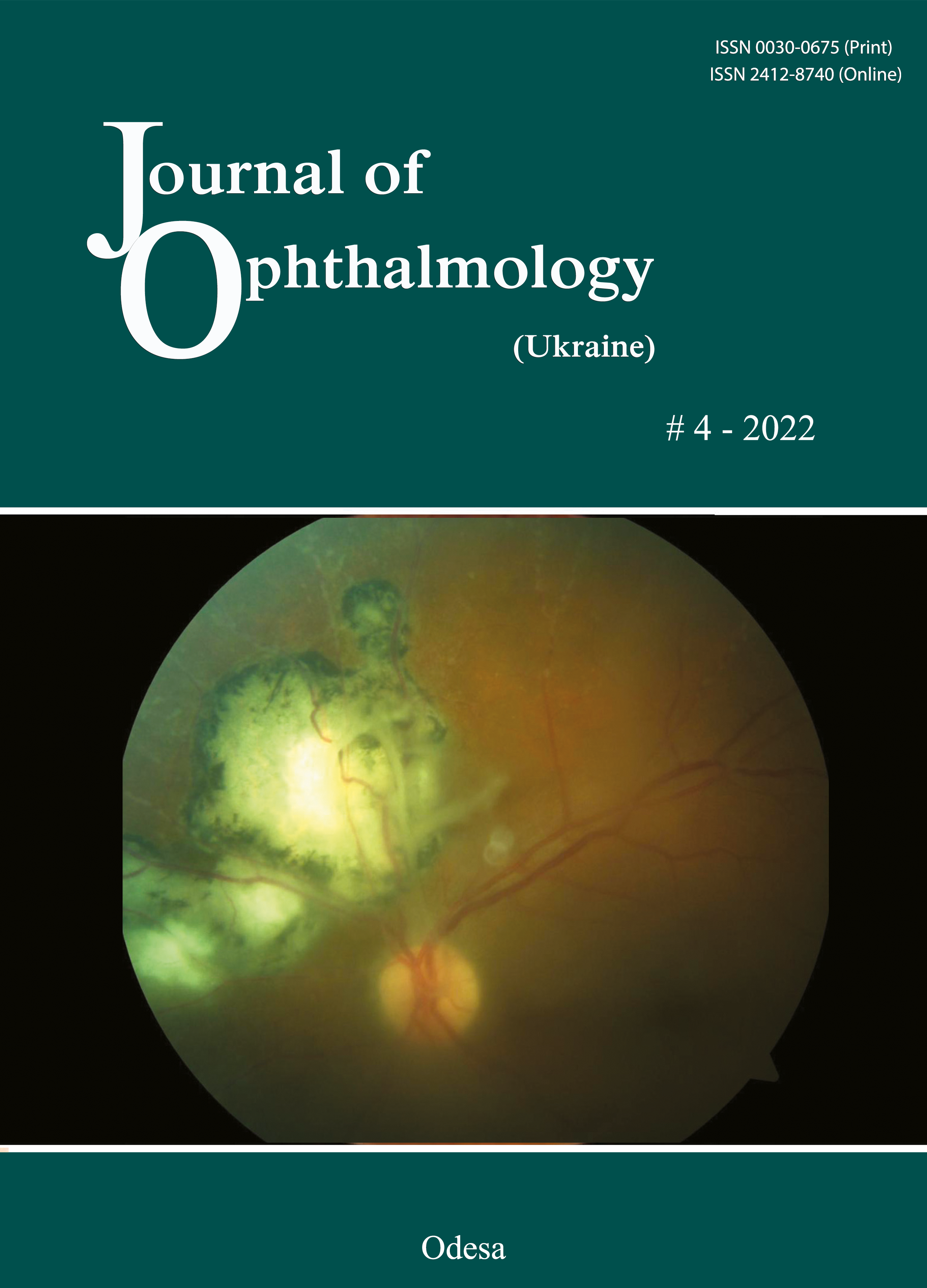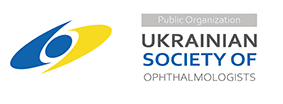Neuropsychological diagnostics and correction of reading disorders in visually impaired children
DOI:
https://doi.org/10.31288/oftalmolzh202246874Keywords:
reading disorders, dyslexia, neuropsychological diagnostics, neuropsychological correction, visually impaired children, difficulties in regulation and controlAbstract
From year to year, there has been an increase in the number of children with poor reading skills. The paper focuses on a neuropsychological approach to assessing reading learning difficulties in visually impaired children.
Purpose: To examine the impact of neuropsychological characteristics on reading learning difficulties in visually impaired children.
Material and Methods: The study sample included 72 children aged 8-12 years; of these, 36 had a vision impairment. We used a battery of neuropsychological tests proposed by Luria and adapted for children by Glozman. Statistical analysis was conducted using IBM SPSS Statistics 23 software.
Results: There was a significant difference (p < 0.05) in neuropsychological test results between the experimental group and controls. The neuropsychological symptom complex (cluster) for visually impaired children comprises certain markers of regulation and control like Difficulties in Memorizing a Series of Elements, Difficulties in Retaining Semantic Elements of a Text, Immaturity of Holistic Reading, Slow Reading, Impossibility to Make a Program for an Arithmetic Problem, Difficulties in Naming the Found Category, and Situational Generalization.
Conclusion: It was found that the degree of the maturity of neuropsychological characteristics (regulation mechanisms) in the domains of motor and intellectual functioning has an effect on learning difficulties in reading in visually impaired children. Understanding the neuropsychological mechanisms of reading disorders in visually impaired children has a key value for neuropsychological differential diagnosis with subsequent correct identification of targets for neuropsychological correction.
References
1.Caqueo-Urízar A, Mena-Chamorro P, Atencio-Quevedo D, Flores J, Urzúa A. Self-esteem in adolescents with learning difficulties: A study from the perspective of the students, parents, and teachers. Psychology in the Schools. 2021; 10 (58):2031-2040. https://doi.org/10.1002/pits.22572
2.Medvedovska NV. Results of the study on the impact of eye disease on child quality of life. J Ophthalmology (Ukraine). 2021; 6:48-51. https://doi.org/10.31288/oftalmolzh202164851
3.Coelho VA, Marchante M, Jimerson SR. Promoting a Positive Middle School Transition: A Randomized-Controlled Treatment Study Examining Self-Conceptand Self-Esteem. J Youth Adolescence. 2017; 46:558-569. https://doi.org/10.1007/s10964-016-0510-6
4.Atowa UC, Hansraj R, Wajuihian SO. Visual problems: a review of prevalence studies on visual impairment in school-age children. Int J Ophthalmol. 2019; 12(6):1037-1043. https://doi.org/10.18240/ijo.2019.06.25
5.Kiparenko OL. [Sensory integration as a method of correction of disorders in children]. Problemy suchasnoi psykholohii. 2020; 49:152-176. Ukrainian.
6.Nielsen AN, Brand F, La Cour A. Exploration of Sensory Processing Difficulties among Children Attending Primary School in Denmark. Occup Ther Int. 2021 Mar 24;2021:8893345. https://doi.org/10.1155/2021/8893345
7.Falkenberg HK, Langaas T, Svarverud E. Vision status of children aged 7-15 years referred from school vision screening in Norway during 2003-2013: a retrospective study. BMC Ophthalmol. 2019; 19 (1):180. https://doi.org/10.1186/s12886-019-1178-y
8.Foreman J, Salim AT, Praveen A, Fonseka D, Shu Wei Ting D, Guang He M, et al. Association between digital smart device use and myopia: a systematic review and meta-analysis. Lancet Digit Health. 2021 Dec;3(12):e806-e818. https://doi.org/10.1016/S2589-7500(21)00135-7
9.Hulme C, Snowling MJ. Reading disorders and dyslexia. Curr Opin Pediatr. 2016; 28(6):731-735. https://doi.org/10.1097/MOP.0000000000000411
10.Brem S, Maurer U, Kronbichler M, Schurz M, Richlan F, Blau V, et al. Visual word form processing deficits driven by severity of reading impairments in children with developmental dyslexia. Sci Rep. 2020 Oct 30;10(1):18728. https://doi.org/10.1038/s41598-020-75111-8
11.González-Valenzuela MJ, Martín-Ruiz I. Neuropsychological Perspective on Dyslexia. In: Learning Disabilities - Neurobiology, Assessment, Clinical Features and Treatments. Intech Open; 2021. https://doi.org/10.5772/intechopen.99386
12.Glozman J, Nemeth DG. The contributions of Luria and Reitan to developmental neuropsychology and to the understanding of neuropsychologically compromised children. In: Nemeth DG, Glozman J (Eds.) Evaluation and Treatment of Neuropsychologically Compromised Children. London: Academic Press; 2020: p. 1-26. https://doi.org/10.1016/B978-0-12-819545-1.00001-1
13.Tsybulska TE, G. Zavgorodnya NG, Pashkova OE. Predicting the risk for progression of acquired myopia in school-age children. J Ophthalmology (Ukraine). 2018;1:7-12. https://doi.org/10.31288/oftalmolzh20181712
14.Kobylchenko V. [Visual perception and its disorders in childhood]. Osoblyva dytyna: navchannia i vykhovannia. 2020; 4(93):46-59. Ukrainian.
15.Glozman JM, Soboleva AE. [Neuropsychological assessment of school-children]. Moscow: Smysl Publishing House; 2018. Russian.
16.Kiparenko OL. Neuropsychological determinants of dyslexia in schoolchildren. Scientific Journal of Polonia University. 2021; 46(3):235-240. https://doi.org/10.23856/4631
17.Luria AR. [Higher cortical functions in man]. Saint Petersburg: Piter; 2019. Russian.
18.Nielsen F. Hierarchical Clustering. In: Nielsen F (ed.). Hierarchical clustering BT - Introduction to HPC with MPI for data science. Springer; 2016;304 https://doi.org/10.1007/978-3-319-21903-5_8
19.Maimon O, Rokach L. Clustering methods. In: Ed. Data Mining and Knowledge Discovery Handbook. Springer; 2006: 321-352. https://doi.org/10.1007/0-387-25465-X_15
20.Kiparenko O, Kremenchutska M. Assessment of the impact of motor development on adaptation to learning. Insight: the psychological dimensions of society. 2021; 6: 95-109. https://doi.org/10.32999/2663-970X/2021-6-7
Downloads
Published
How to Cite
Issue
Section
License
Copyright (c) 2025 М. К. Кременчуцька, О. Л. Кіпаренко, Л. Д. Чикур, В. В. Пундєв, І. В. Добриніна

This work is licensed under a Creative Commons Attribution 4.0 International License.
This work is licensed under a Creative Commons Attribution 4.0 International (CC BY 4.0) that allows users to read, download, copy, distribute, print, search, or link to the full texts of the articles, or use them for any other lawful purpose, without asking prior permission from the publisher or the author as long as they cite the source.
COPYRIGHT NOTICE
Authors who publish in this journal agree to the following terms:
- Authors hold copyright immediately after publication of their works and retain publishing rights without any restrictions.
- The copyright commencement date complies the publication date of the issue, where the article is included in.
DEPOSIT POLICY
- Authors are permitted and encouraged to post their work online (e.g., in institutional repositories or on their website) during the editorial process, as it can lead to productive exchanges, as well as earlier and greater citation of published work.
- Authors are able to enter into separate, additional contractual arrangements for the non-exclusive distribution of the journal's published version of the work with an acknowledgement of its initial publication in this journal.
- Post-print (post-refereeing manuscript version) and publisher's PDF-version self-archiving is allowed.
- Archiving the pre-print (pre-refereeing manuscript version) not allowed.












